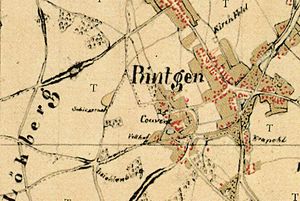Klostermühle (Viersen)
| Monastery mill
|
||
|---|---|---|
|
Tranchot map from 1806 |
||
| Location and history | ||
|
|
||
| Coordinates | 51 ° 15 '9 " N , 6 ° 23' 20" E | |
| Location | Germany | |
| Waters | Rintger Bach | |
| Built | First mentioned in 1246 | |
| Shut down | circa 1880 | |
| technology | ||
| use | Grain mill later oil mill | |
| Grinder | 1 grind 1 oil press | |
| drive | Watermill | |
| water wheel | undershot | |
The monastery mill in the town of Viersen was a water mill with an undershot water wheel .
Mills in Viersen
In the past centuries there were a total of 18 mills in the municipality of Viersen. Four of them were used as hammer mills . These were operated by horse power. There were also two windmills , the Hoser and Hüsterfeld windmills , both of which were privately owned.
It was different with the watermills. The pen St. Gereon in Cologne had the basic rule of Viersen and the water rights on the streams in Viersen. The construction of watermills required his approval. The monastery granted mill rights as a hereditary fiefdom and received an annual tenancy from them. This had to be delivered to the parish office of St. Remigius. These documents show that there were twelve water mills in Viersen as early as 1246. All mills, with the exception of the monastery mill, paid a sum (about one hundredweight) of malt annually as loan interest. In the glory of Viersen there was no pressure to mill . All farmers could have milled wherever they wanted.
These twelve mills were on:
- " Dorfer Bach ": Kaisermühle , Kimmelmühle , Goetersmühle , Biestenmühle and Schricksmühle
- " Hammer Bach ": Plinzenmühle , Schnockesmühle , Sgoedenmühle , Bongartzmühle , Hüstermühle and Hammer Mühle
- " Rintger Bach ": Klostermühle
geography
The buildings of the Klostermühle were located at 20 Klostermühle in the town of Viersen in the Viersen district. In front of the mill was a pond , which was fed by the Rintger Bach and whose water level was 44 m above sea level. The care and maintenance of the stream is the responsibility of the water and soil association of the Middle Niers, which is based in Grefrath .
history
The monastery mill, formerly also called Riethmühle, was the only mill on the Rintger Bach. It belonged to the established 1408/24 Begin Convent St. Pauli. The mill was exempt from the annual payment of the loan interest, which became known in 1246. The grain mill only worked for the monastery's own use . In 1809, their daily grindability was one Malter Grain. In 1829 the mill was recorded as an oil mill . It had therefore been converted into an oil mill. About 50 years later it was closed.
literature
- Hans Vogt: Lower Rhine water mill guide. Krefeld 1998, pp. 511-523.
- Ferdinand Dohr: About the water being in old Viersen. In: Heimatbuch des Kreis Kempen-Krefeld, 25th episode / 1974, pp. 47–55.

